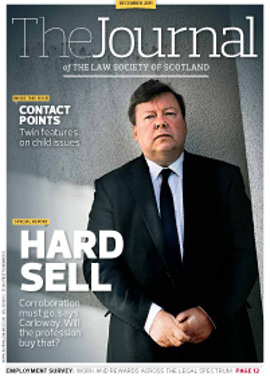Book reviews

Drafting for Succession
2nd edition
John Kerrigan
PUBLISHER: W GREEN
ISBN: 9780414017719
PRICE: £93.60
This is a book which aims to be a teaching tool for law students, and a professional and practical guide for solicitors. There is a lot of material in its 562 pages, and much food for thought, but does it achieve its aims? It does so only partially.
There is some good practical advice on will writing practices and procedures, and on the topics which should be raised with clients across a range of issues which occur in the field of succession, useful in an increasing litigious area. There is an interesting introduction to the topic of Islamic wills, and a helpful analysis of duties to third parties.
However, some areas of the book are weak on analysis and explanation. For example, the discussion of the investment provisions of the Charities and Trustee Investment (Scotland) Act 2005 is not really accurate, and the explanation of the genesis of this legislation and of the (English) Trustee Act 2000 overlooks the joint report of the Law Commission and the Scottish Law Commission of 1999 on which the legislation was based. There are some frustratingly enigmatic comments such as “Failure to think outside the box”: probably not negligence, but it will undoubtedly take a trick with clients if the draftsman can demonstrate the above ability, as was evidenced by the solicitors who dealt with the case of Mrs H T.
The book contains some helpful styles, also provided on CD-rom. Again there are some points which could usefully be more fully explored. For example, one of the will styles contains a discretionary trust with a provision for automatic termination two years after death, in favour of the residuary beneficiaries. This two year termination does not seem to be necessary, and reduces the flexibility of the discretionary trust arrangement, and the point could usefully have been discussed in the accompanying author’s note on the style, albeit it is covered elsewhere in the book.
The book is held back by two other characteristics. The first is its use of what seems rather outdated language in some areas of the text and of the styles, which the experienced practitioner will probably now wish to amend anyway, but which a student might find rather impenetrable. The second is some poor proofreading, which affects both wording and punctuation, and tends to undermine one’s confidence in the work.
This book is probably most useful for the experienced practitioner looking for a discursive approach to an issue in practice, and styles to consider and adapt. Its language is likely to be a barrier to law students, for whom a more straightforward explanation and layout of text would be more helpful, in the context of a shorter book. This book would not be my first choice as an aid to drafting, but could be a useful supplement to other works.
The Evolution of EU Law
2nd edition
(ed) Paul Craig and Gráinne de Búrca
PUBLISHER: OXFORD UNIVERSITY PRESS
ISBN: 9780199592968
PRICE: £39.95
This book aims to provide a comprehensive overview of the evolution of EU law over the past decade, in order to give the reader a clearer understanding of the broader picture of EU legal development. It does this by looking at the social and political influences brought to bear on EU legal policy over that period, such as the growth of transnational crime and terrorism, global warming and financial meltdown. It also examines the impact of major constitutional reforms such as the Lisbon Treaty.
Each contributor’s point of view stands on its own. While this type of approach generally works well at a conference, the danger, as is found here, is that there will be overconcentration on certain areas, and omissions from the overall picture. Greater editorial control might have avoided this. There are some very eminent contributors to this book, and one can’t help but wonder whether this may have led to a reluctance to prune some of the more unwieldy chapters.
Shorter, more incisive sections in more user friendly language would have made the book more accessible to a wider readership. Good speakers often produce lively, readable prose, and the chapters by Catherine Barnard and Tom de la Mare and Catherine Donnelly do not disappoint. Similarly, those contributors who work in the EU institutions or appear regularly in the European Court of Justice offer interesting points of view. You may not agree with them, but their chapters feel authentic and engaging.
The book would have significantly benefited from a concluding section, tying up all of the contributors’ views. Doing this might also have served to highlight omissions in certain areas. For example, while the chapter on EU enlargement is excellent on the mechanics, it provides little analysis of how the recent wave of accessions has affected EU business. In a tome as lengthy as this it may be disappointing to readers to find that the story is not fully comprehensive. In short, while many of the chapters are interesting and informative, the book does not always convey what all of these authors undoubtedly realised long ago – that working in Europe is fascinating.
In this issue
- Involving the named person
- Private investigators - mitigating the risks
- Human inventions
- Smoother passage
- Rough law of the street
- Council profile
- Opinion
- Book reviews
- President's column
- Mapping in the Land Register
- Alien concept
- Size does matter
- Case proved?
- Reading for pleasure
- Relocation revisited
- Where Parliament fears to tread...
- Cadder's growing family
- Landlord splits
- Five-year-old experts
- Common sense to the fore
- Beware: earn-outs
- Steering with one hand
- Scottish Solicitors' Discipline Tribunal
- Missives in motion
- Constitution on track
- From the Brussels office
- Law reform update
- Ask Ash
- Outside the box






